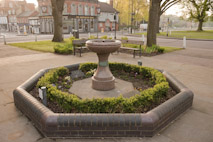Detailed Programme of Lectures 2024-2025
2024-2025 PROGRAMME
Lectures 2024
September 18th
A CONCISE HISTORY OF OUR GREAT BRITISH PUBLIC PARKS
Lecturer: Paul Rabbitts
This fascinating insight into the history of one of our greatest institutions - the Great British Public Park - gives examples of parks across the UK, and their designs and architecture.. We all enjoy them but what do we really know about them? What are their origins? This talk ranges from the great Royal Parks through 18th century Pleasure Gardens, to their Victorian heyday, their decline in the sixties, seventies and eighties, and now a renewed interest in and affection for them. What makes a great park? A combination of many features including lodges, lakes, bandstands, fountains, lidos, palm houses and wonderful floral displays – in short, its ‘parkitecture’.
Oct 16th
The Golden Age of Fashion Illustration
Lecturer: Connie Gray
Connie Gray
is an expert on 20th century fashion
illustration and its legacy with influential fashion publications
and great couture houses, lecturing in the UK and US and an advisor
to The Courtauld Institute and Special Collections at FIT, New York.
As a curator and archivist, she works closely with institutions and
foundations She also presents a series of on-line masterclasses,
talks and short films on fashion illustration.
Nov 20th
From Tchaikovsky to Tin Pan Alley Uplifting music for Christmas
Lecturer: Sandy Burnett
An hour of festive music from
across the globe – sparkling moments from The Nutcracker,
heartwarming Mel Tormé, a heavenly chorus by Bach, a more cynical
take by Eartha Kitt Sandy Burnett’s roles include author, bassist,
conductor, and award winning broadcaster, sharing his passion for
music. A Cambridge graduate, he was musical director for the
National Theatre and Royal Shakespeare Company and later a regular
Radio 3 presenter. His Idler Guide to Classical Music covers a
thousand years of classical music. He also leads cultural holidays.
Lectures 2025
Jan 29th 2025 (Note
later date!)
Battersea Power Station: The Four Iconic Chimneys
Lecturer: Ian Swankie
Ian Swankie is a proud Londoner
with contagious enthusiasm for his city. At its peak, Battersea
Power Station supplied a fifth of London’s electricity. Shut down
and decommissioned since 1983. Europe’s largest urban regeneration
project restored and repurposed this architectural icon
Feb 19th
Miss Saigon: The Making of a Musical
Lecturer: Jamie Hayes
RADA trained Jamie Hayes has an illustrious career directing opera and musical theatre. As Associate Director of Miss Saigon’s original production in the West End and Broadway, he illustrates his lecture with unique film of rehearsals and world premiere, describing the page-to-stage process for major musical productions, the many elements and talents needed for a West End hit. Producing, directing, auditions, script development, set design, lighting, costumes, orchestration, choreography, advertising, even landing a helicopter on stage!
March 26th (Note
later date!)
Charles 1st, King & Collector
Lecturer: Barbara Askew
Barbara Askew is an
historian and acknowledged expert on Royalty and Windsor Castle. The
only Blue Badge Guide accredited for the Albert Memorial, she trains
Blue Badge guides. Charles I began his art obsession after seeing
King Philip IV of Spain’s magnificent collection, buying the
fabulous collection of the Dukes of Mantua including works by Titian
and Raphael; he engaged Rubens to paint the Whitehall Banqueting
House ceiling and appointed Van Dyck as his Court Artist. Overall,
he amassed over 2000 works, thereby bankrupting the nation.
April 23rd (Note
later date!)
Westminster Hall: 900 Years of Pomp and Circumstance
Lecturer: Caroline Shenton
Caroline Shenton , public
historian, archivist and prize winning writer, teaches postgraduates
at Dundee University, and was Political Writer in Residence in 2017
at Gladstone’s Library. William the Conqueror’s son, William Rufus,
created the great Anglo-Norman feasting hall. The heart of the
Palace of Westminster for 900 years, it hosted royal magnificence,
coronation feasts, law courts, chivalric games, government
departments, state trials, bookstalls, and royal lyings-in-state.
May 21st
William Morris at Home
Lecturer: Joanna Banham
Joanna Banham was Head of Adult Learning at the V&A from 2006 –16 and has curated international exhibitions. William Morris considered a beautiful home to be “the most important production of Art” and much of his working life was devoted to the production of household goods that were intended to bring art and beauty into a wide range of homes including his own. This lecture explores not only the decoration, but also the relationships and lifestyles associated with each of these very different homes.
June 18th
The Dancing Faun, a personal story of a masterpiece
Lecturer: Bertie Pearce
Bertie Pearce recounts the extraordinary tale of how a small bronze statue, in his Grandfather’s garden for 40 years, was found to be a masterpiece, ending up in the Getty Museum, California. Adriaen De Vries (c.1556-1626) a Northern Mannerist sculptor and technical virtuoso born in the Netherlands, created spectacular bronzes for discerning patrons, including Holy Roman Emperor Rudolf II of Prague. He excelled in refined modelling and bronze casting and in the manipulation of patina and became the most famous European sculptor of his generation.
July 16th (AGM
at 7.30)
The Golden Age of British Comedy
Lecturer: Tyler Butterworth
Tyler Butterworth, actor and son of the famous duo Janet Brown and Peter Butterworth, has appeared in many films and television. It’s said in our theatrical history that the 1970’s to the 1980’s was the Golden Age of British Comedy, a wonderfully rich period of shows, as we started to drift away from theatres and radios. Some say this period has never been bettered.

